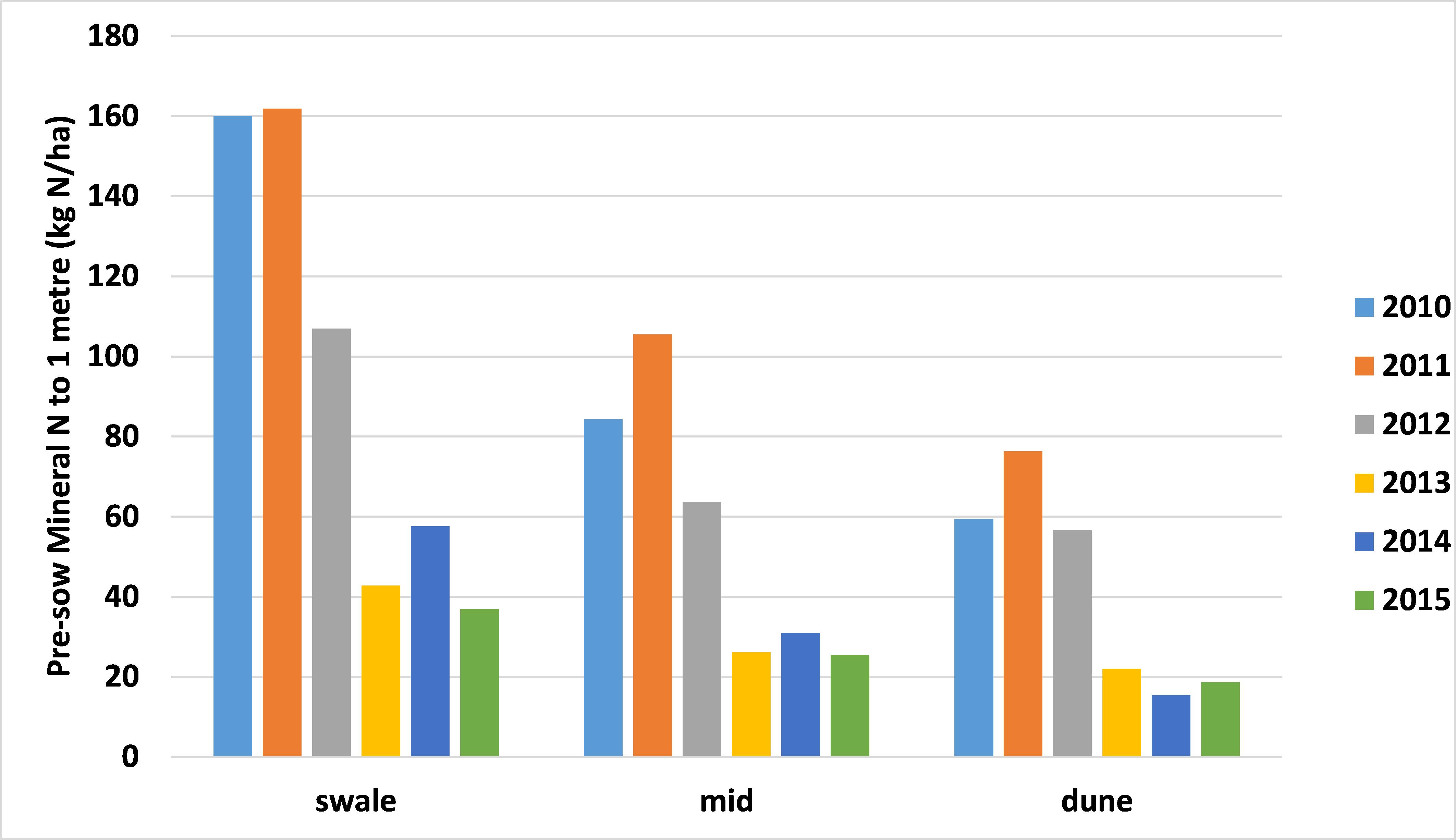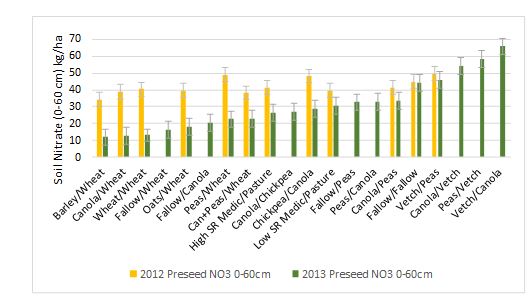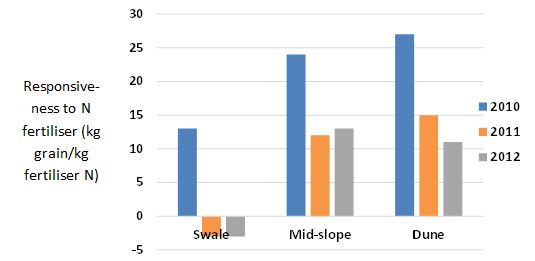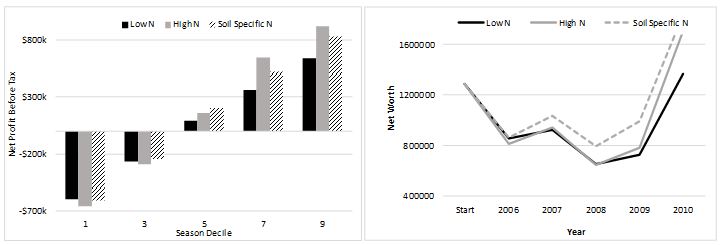Managing the profit and risk of fertiliser nitrogen investment in sandy soils
Author: Therese McBeath, Rick Llewellyn, Vadakattu Gupta, Bill Davoren, Jackie Ouzman, Marta Monjardino (CSIRO Agriculture, Waite Campus, SA) and Michael Moodie (Mallee Sustainable Farming, Mildura, Vic) | Date: 19 Jul 2016
Introduction
Nitrogen fertiliser inputs are a key driver of crop productivity on sandy Mallee soils. In this article we will use research outcomes from Mallee based projects running over the last seven years to give examples of how sandy soils can be managed for the best profit and risk outcome.
How much N do I have?
A key factor in making the most profitable decision on fertiliser N input is knowledge of how much N you should expect your soil system to supply. The amount of mineral N in the soil profile at sowing reflects N mineralisation through microbial activity over the previous months, which is influenced by soil biological capacity, crop residue retention, soil organic matter status, tillage, amount and timing of rainfall received, and the carryover of mineral N from the previous season. Pre-sowing mineral N tests on major soil types will give an indication of what is available to the crop from the soil in the early stages of growth.
As an example, pre-sowing mineral N tests from a long term trial where 50kg DAP/ha (9kg N/ha) was applied annually to cereal crops indicated a substantial seasonal range in the amount of mineral N pre-sowing and a general trend of highest mineral N on the swale, less on the mid-slope, and less again on the dune (Figure 1). The relatively low level of pre-sow mineral N over recent years indicates the limited capacity for N mineralisation from soil organic matter under this low-input continuous cereal cropping system.

Figure 1: Pre-sowing soil Mineral N tests to one metre depth on swale (flat), mid-slope and dune soils that received 50 kg/ha DAP (9kg N/ha) each season in 2010-2015.
Different soil types will supply different amounts of N through the process of mineralisation where organic matter is broken down to supply N as mineral N to crop plants. The nitrogen supply potential of a soil is determined by the amount of microbial biomass and microbial turnover. The rate of mineralisation in a growing season is controlled by soil moisture, temperature and the amount and quality of organic matter (e.g. C:N ratio) in the system. However, as a general rule, soils with a higher organic matter content and microbial activity generally supply more N through mineralisation and sandy soils have very low organic matter and microbial biomass contents.
For example, measurements of the N supply potential on swale, mid-slope and dune soils sown to cereal in 2010- 2012 indicate that the topsoil of the swale consistently had the capacity to supply more N to the crop than the sandy mid-slope and dune soils. N supply potential measurements made at sowing can provide an indication of likely in-season mineralisation, dependent on rainfall received within the crop season.
Table 1: Nitrogen supply potential (kg/ha/cropping season in a decile 5 year) of continuous cereal cropping swale, mid-slope and dune soils at Karoonda (McBeath et al. 2015).
| Year and Soil | 2009 | 2010 | 2011 | 2012 | 2013 |
|---|---|---|---|---|---|
| Swale | 37 | 33 | 46 | 58 | - |
| Mid-slope | 25 | 22 | 29 | 32 | 30 |
| Dune | 20 | 22 | 27 | 30 | 25 |
The use of legumes in the crop sequence will increase the amount of N that can be supplied from the soil in the subsequent growing season. Non-cereal break crops also substantially reduce soil-borne pathogens and improve overall root health in the following cereal crops thereby increasing the plants nutrient uptake capacity (Gupta et al. 2012). Break crop experiments at Karoonda have measured benefits in the order of 11-20kg N/ha extra for cereal following a legume compared with following a cereal (McBeath et al. 2015).
Including legume crops and pastures has also provided clear soil nitrogen benefits at the crop sequencing site at Mildura (Moodie et al. 2015) (Figure 2). Prior to sowing in 2012, 0-60cm nitrate levels were about 50kg/ha in plots where vetch, chickpea and field pea had been grown in 2011 while for the non-legume treatments (except for medic pasture) levels were 30 – 40kg/ha. Prior to sowing in 2013 (green bars in Figure 2), soil nitrate levels were 20 - 60kg/ha where a legume break phase had been included over the previous two years while for treatments where no legume break had been included in the rotation, soil nitrate levels were below 20kg/ha. Brown manure vetch has proven to be the best break phase for boosting soil nitrate levels. The four rotations where brown manure vetch had been included had the highest 2013 soil nitrate levels.

Figure 2: 0-60 cm soil nitrate (kg/ha) measured prior to seeding in in 2012 and 2013. Error bars represent the standard error of each treatment. Note: soil nitrate was only measured for each crop type in 2012 and not for each treatment.
How much fertiliser N will the crop need?
Armed with some knowledge of the amount of N that a soil type is expected to supply to a crop, the next important estimate to help decide how much fertiliser N to add is the amount of yield that is likely to be produced. While rainfall is the biggest factor determining yield and the hardest to predict, it is still possible to adjust the expected yield according to soil type by understanding a few key drivers of yield potential.
Even within the sandy soil types we know that there is variation in the ‘bucket size’ or plant available water capacity. This can be determined by the presence of constraints to crop water access. For example the constrained dune-crest at the Karoonda trial site has a bucket size of just 31mm, while the dune and mid-slope sandy soils have 120 and 110mm. Because of the small bucket size and lower resulting potential yield on the dune-crest, N inputs on these soils need to be moderated to account for these constraints.
Using an estimated yield potential and assuming fertiliser N efficiency of 50 per cent, the amount of N required to achieve each tonne of wheat yield is approximately 40kg N (Kumar Fageria et al. 2010). The N can come from the combination of the pre-sowing mineral N, in-season mineralised N and fertiliser N.
While we often use the assumption of 50 per cent fertiliser efficiency, it should be noted that response to or recovery of fertiliser N is not uniform across all soils and will depend on the level of N deficiency, the growing season rainfall, the presence of other constraints to crop production and the efficacy of N application.
The responsiveness of wheat crops to fertiliser N input produced in dune, mid-slope and sandy soils for the growing seasons 2010-2012 at Karoonda is shown in Figure 3.

Figure 3: Wheat crop responsiveness to fertiliser N input (kg grain/ kg fertiliser N) on swale, mid-slope and dune soils at Karoonda in 2010-2012.
At the soil type level, the profit from N investment is directly related to the responsiveness to the N input.
How do I manage risk?
In most Mallee paddocks the different soil types deliver very different levels of profit and risk when it comes to returns from N fertiliser. For example, at Karoonda SA, the sandy mid-slope, dune crest and dune soil wheat crops have consistently responded profitably to inputs of N, even with repeated inputs of 40kg N/ha, while on the swale soil there has been little or no profitable response over the period 2010-2015 (Table 2).
Cumulative gross margins show benefits of +$1014/ha on the mid-slope and +$1150/ha on the dune by shifting from 9 to 40kg/ha N fertiliser but only +$230/ha on the swale. Even the poorly yielding dune crest soil generated a highly profitable response to increased N fertiliser (+$996). It should be noted though that there are indications that sustained very low inputs of N to swales depletes N fertility levels and this needs to be monitored to ensure the sustainability of the system.
Table 2: Cumulative gross margin (2010-2015 $/ha) from continuous wheat production comparing 9 and 40kg N/ha applied at sowing to key Mallee soil types at Karoonda. Gross margin input costs and commodity prices derived from Rural Solutions Gross Margin Guide.
| Soil | 9 kg N/ha | 40 kg N/ha |
|---|---|---|
| Swale | 3090 | 3321 |
| Mid-slope | 2307 | 3321 |
| Dune-crest | -40 | 956 |
| Dune | 660 | 1810 |
To properly consider the risk of the investment in N, scaling up to the farm level is necessary. We generated a farm case study to explore the outcomes of adopting fixed low urea input and fixed high urea input compared with soil specific inputs of urea across a range of growing season deciles (Figure 4, Moodie et al. 2015). The outcome of this analysis was that soil-specific or variable rate N, with higher N rates on sands could improve the risk outcomes through less losses in poor seasons while capturing most of the upside (profits in better seasons). Over the five year analysis this soil-specific N strategy increased farm net worth compared to both low and high fixed N input across all soil types (Figure 4).

Figure 4: (left) Annual farm net profit before tax across season type and (right) farm net worth across a selected run of seasons for; fixed low N input (14kg N/ha in all soils), fixed high N input (37kg N/ha in all soils) and soil-specific urea input (37kg N/ha on the dune, 18kg N/ha on the mid-slope, and 9kg N/ha on the swale) N management scenarios on a 2400ha farm producing 2040ha of wheat and 360ha of canola. Growing season rainfall deciles were 2 (2006), 5 (2007), 3 (2008), 5 (2009) and 10 (2010). (Source: Moodie et al. (2015)).
With all of this information, the farm-level decision of the level of N investment will still always be a function of the risk preference of the decision maker. Of importance to growers in the Mallee, where risk is particularly important in decision making, is that we have been able to demonstrate that being able to increase inputs of N on sands, relative to the heavier soils, will result in a less risky outcome.
Acknowledgements
Funding for this work was from GRDCs Water Use Efficiency Initiative, Stubble Retention Initiative and More Profit from Crop Nutrition Initiative and CSIRO Agriculture in partnership with Mallee Sustainable Farming. Their support is gratefully acknowledged. Thanks to the Loller family (Karoonda) and to the Bulla Burra Farm (Loxton) for their generous support in hosting the trials. Thanks to Robin Schaeffer, Matthew Whitney, Jeff Braun and Lou Flohr for discussions around trial design.
Useful resources
Kumar Fageria et al. (2010) Chapter 8. Wheat and Barley, Growth and Mineral Nutrition of Field Crops, CRC Press.
Gupta, V.V.S.R. et al (2012). Break crops for disease and nutrient management in intensive cereal cropping. In: Capturing Opportunities and Overcoming Obstacles in Australian Agronomy". Edited by I. Yunusa. Proceedings of 16th Australian Agronomy Conference 2012, Armidale, NSW. http://www.regional.org.au/au/asa/2012/nutrition/7961_vadakattugupta.htm
McBeath et al. (2015) Break-crop effects on wheat production across soils and seasons in a semi-arid environment. Crop and Pasture Science 66:566-579.
Moodie et al. (2015) Nitrogen management: a key driver of farm business profit and risk in the low rainfall Mallee. Proceedings of the Australian Agronomy Conference Hobart, Tasmania.
Moodie et al. (2015) Two year breaks profitably reduce agronomic constraints in the Northern Victorian Mallee. MSF Research Compendium http://www.msfp.org.au/two-year-breaks-profitably-reduce-agronomic-constraints-northern-victorian-mallee
Contact details
Therese McBeath
Agriculture, CSIRO, Waite Campus
08 8303 8455
therese.mcbeath@csiro.au
Rick Llewellyn
Agriculture, CSIRO, Waite Campus
08 8303 8502
rick.llewellyn@csiro.au
Was this page helpful?
YOUR FEEDBACK
